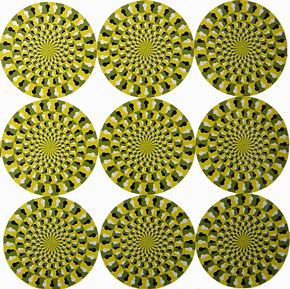Critical Note on Apparatus
Michael R. Stevenson
I imagine that the title of Program’s first exhibition, Apparatus, astutely and perspicaciously curated by Adina Popescu, refers to the “subjective” apparatuses—imaginative and cultural—which structure our experience and interpretation of reality. For me, then, the exhibition is an exploration of the transcendental and hermeneutic conditions of perception, and of the vicissitudes of imagination’s role in our “seeing”. Philosophy and experimental psychology have tended to focus on rational and conceptual cognitive processes in perception; but behind the role of reason has always lurked the more shadowy role of imagination in the “construction” of reality. The question I find resonating to various degrees in all these works is the following: Is imagination—by which I mean free and creative, though non-rational and thus non-rule-governed, mental activity—always some merely subjective flight of fancy which drags us away from or beyond the objective, or does it play an essential role in our experience of the world, that is, in the construction of the objective as such? Do I need imagination to tell me what there is, what is there, in the first place?
We all know imagination can outstrip or upset what is “really there”, as in dreams, hallucinations, and any number of optical illusions. In this vein, Agnieszka Kurant’s pattern of repeating Rorschach images questions the determinancy of what we see, while David Woodward’s dream machine promises a visionary experience, a perception of new or deeper realities lying behind or underneath the ordinary. Other works in the exhibition explore the extent of free activity in our experience of the everyday. There is first of all, of course, the simple matter of where to look, the directionality of one’s gaze. The gallery space of the art world, like any other part of human culture, provides a structure that determines this most simple aspect of our seeing. One might be forgiven, then, for missing entirely Pash Buzari’s candy wrapper, hidden on the ceiling, or failing to notice at all Jordan Wolfson’s North American-style electrical outlets, at once completely in, and totally out of, place. These pieces remind me of Heidegger’s point that something becomes really present in its independent object-hood only when there is a disturbance or breakdown in the ordinary expectations of experience and everyday activity, when familiar things are made to become somehow strange; as it would, for example, if I were to try to plug something in to the outlets.
There is the matter, too, of how hard I bring my attention to bear, on what I take to be the important or relevant aspects of what I’m seeing. One might learn only afterwards, as I did, that Buzari’s Dark Side of the Moon vinyl cover, seemingly ersatz, is a “real” copy, painted over. These works, as well as Stefan Roigk’s impressive sound piece, enact the movement between the unnoticed and the strange, the familiar and the overfamiliar, and thus invisible. The latter is an octopus-like arrangement of speakers which emit crisp reproductions of everyday sounds—we hear crackles, hisses, paper sliding, a footfall, a soft crash, the quiet tinkling of broken glass—which are fascinating despite or rather because of their overwhelming familiarity, and which vanish as soon as we are distracted by something else, and for the same reasons.
Two works in particular carry my guiding question to its limit: Jeppe Hein’s No Presence (Yellow), a neon globe which only glows when no one is moving, and Warren Neidich’s Body Wall, a hidden corridor illuminated with perverse red lights, and lined with peepholes affording various views of the gallery space, including one of a mirror which can be manually rotated to offer a constantly changing perspective. These pieces make us aware of two things. Perhaps at first they seem to point to the sociality of the aesthetic experience, of the presence of others as a condition of meaning. That is of course if there are others present. Seeing the show alone affords a different significance, as one is only aware, and necessarily so, of oneself, as spectator. The neon globe then becomes almost an annoyance, its blinking constantly calling one out and reminding one of the singularity of their own presence and of their own body in motion. Any attempt to get closer, to have a look, signals an alarm as it were, that you are there, that you are having a look. Likewise and more so, Body Wall, in the first instance similarly affording the opportunity for surveillance, becomes most disarming when one catches one’s own gaze in the mirror.
This paradoxical image—the eye seeing itself seeing—reminds me of Kant’s principle of apperception, namely, that self-consciousness is a necessary condition of consciousness, and thus of experience of the world. Das: Ich denke, muß alle meine Vorstellungen begleiten können. Interpretation of the world is always a self-interpretation, and vice versa. And it is as well an image which evokes the theme I attributed to these works at the outset, that is, as bringing our attention to bear on the subjective conditions of objectivity, and the role of imagination as such a necessary condition. Imagination activates both our receptivity—our openness to the world as it is—and our free and creative processes of making-sense of things precisely by articulating ahead of time the frame in which things can show up for us as significant. For me, the works in this exhibition function not to frame the world, then, but rather to “frame” the structure of this necessary process of framing itself.

(image Uzumaki (rabbit spirals), from Trick Eyes II by Akiyoshi Kitaoka)
---
Michael Stevenson is a PhD candidate in Philosophy at Columbia University in New York. He is currently living in Berlin on a DAAD research grant.